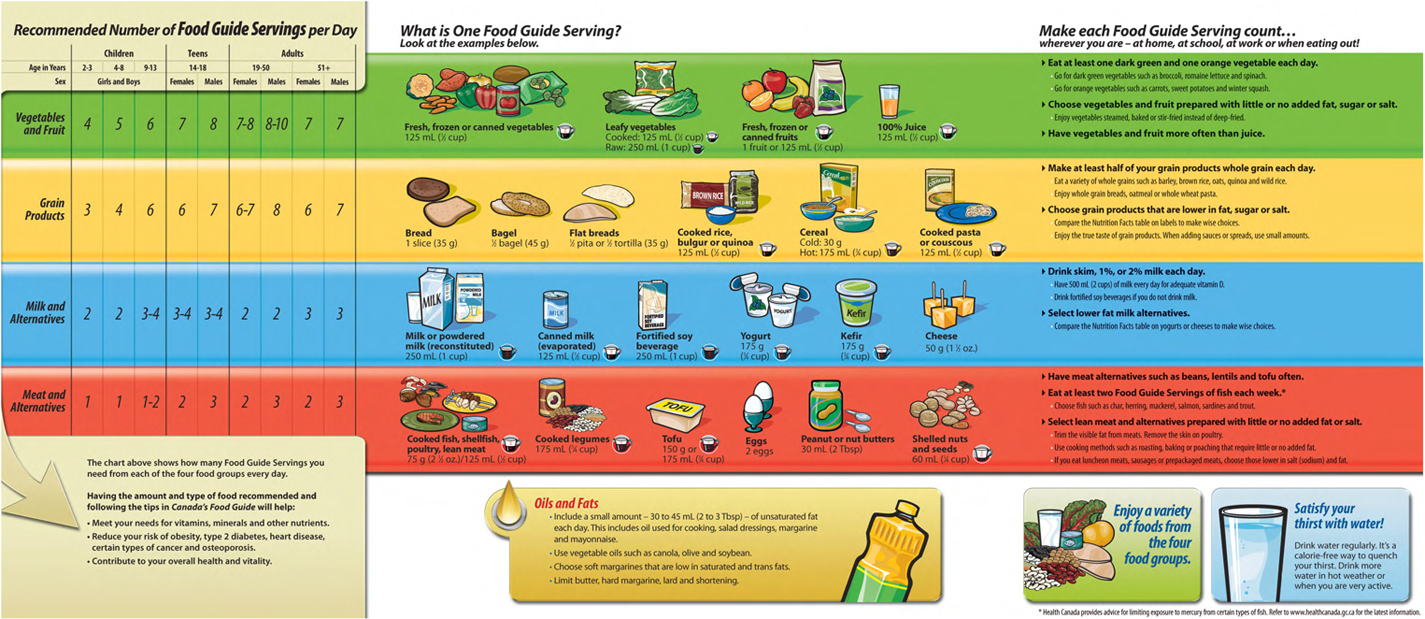I have found that in discussions with colleagues and other healthcare professionals that there is a certain degree of disdain and even a lack of confidence in Canada’s national nutrition guidelines, known as Canada’s Food Guide.
I have to honestly admit that, although I agree the guide is not without its limitations, I find it to convey several very valuable messages.
In today’s article, I will discuss some of the aspects of the guide that I am most fond of, as well as some of the areas that I believe need to be improved in future generations.
What Canada’s Food Guide Does Well
1. Emphasizes Fruits, Veggies & Whole Grains Above All Else: Canada’s food guide makes it crystal clear that these foods should represent the most significant component of our diet. Much of the strongest available scientific evidence shows us that diets rich in fruits, vegetables and whole grains confer the greatest level of protection against chronic disease and help to ensure that most people can hit their daily nutrient requirements while maintaining a healthy weight. The food guide also notes the importance of consuming a variety of vegetables and ensuring that people choose whole fruits and vegetables more often than juices, which is a very important consideration.
2. Encourages The Frequent Consumption Of Meat Alternatives: Our food guide suggests to have meat alternatives such as beans, lentils and tofu often. This is an incredibly important point to acknowledge because the current state of science tells us that when we choose plant-based protein sources most often, we tend to have better health outcomes.
3. Makes Special Note Of Fish Consumption: Fish is the only true rich source of vitamin D in the human diet ( and one of a limited number of sources of omega-3 fatty acids) and the food guide contains the important suggestion to consume at least 1-2 servings of fish weekly. It can be very challenging ( but not impossible) to ensure adequacy in vitamin D in the Canadian winter in the absence of fish consumption, which is why this messaging is so important.
4. Makes Note Of Limiting The Amount Of Oils Used: Although the consumption of vegetable oils ( such as olive oil) can provide us health benefits, we must also recognize that oils are one of the highest sources of calories in our diets that come from foods not belonging to one of the four food groups. Given how many Canadian’s over consume calories relative to their needs, it is important that the food guide puts limits ( 2-3 tbsp) on the amount of oil that any one person should be taking in on a daily basis.
What The Canada’s Food Guide Could Do Better:
1. Emphasize Vegetables Above Fruit: Fruits and veggies are both incredibly important components of our diets but I don’t think that there are many health professionals that would disagree that vegetable consumption should be rated more highly. The current food guide does not really distinguish the relative importance of fruits and vegetables, and could be misleading in this regard. Fruits are incredibly important but consuming 6-7 a day ( which theoretically falls within the current guidelines) is not ideal in the context of current caloric over consumption. I believe in Australia the national guidelines recommend 5 servings of veggies and 2 servings of fruit daily, and this gives a great deal more direction to the average person.
2. Encourage Even More Consumption Of Whole Grains ( Vs Refined): Right now, our food guide suggests that at least half of our grains be whole grains. That is, in my estimation, a modest goal to set. I honestly believe that the message should be to consume whole grains MOST of the time, rather than half of the time. We know that whole grains are the gold standard and there is no reason to shy away from it. I would also love for starchy vegetables ( such as potatoes) to be moved into a hybrid Starchy Vegetable/ Whole Grain category ( as they are nutritionally much more closely related to whole grains than to say, broccoli, for example) as I believe this will provide great value and clarity for the average Canadian.
3. Give Milk Alternatives The Same Recognition As Cow’s Milk: Probably one of the biggest limitations of the Canadian Food Guide is that it does not quite appear to give milk alternatives ( such as fortified soy or almond milk) the same level of recognition as cow’s milk. It is very much presented as if cow’s milk should be the first choice and alternatives should be plan B. In reality, it is very much more like a 1A 1B scenario, where both options are equally viable. In the context of emerging concerns over lactose intolerance, IBS and general gut health I would say it is also worth mentioning that Yogurt and Kefir ( two options listed in the guide) are rich sources of probiotics which may confer some additional health benefits beyond just drinking milk.
4. A Special Message To Avoid/Severely Limit Sugar Sweetened Beverage ( Soft Drinks) Intake: Soft Drink consumption in Canada is a public health concern. Soft drinks represent the #1 source of calories in our diets that does not come from food guide foods, and offer us close to zero nutritional value in return. I believe the Canadian public need to be made aware of this fact in our national nutrition guidelines, potentially with special emphasis placed on adolescents, where the problem is most severe.
What are your thoughts on the Canadian Food Guide? What are your thoughts on MY thoughts on the Canadian Food Guide?
How does it compare to your country’s national nutrition guidelines?
Let me know in the comments section!
Until next time,
Andy De Santis RD MPH



